Today, from security and battlefield readiness to cost savings and efficiency, America’s military is making an unprecedented commitment to renewable energy sources, and solar is “walking point” on many of these new, innovative efforts.
Staff Sgt. Anthony Chambers of the 506th Expeditionary Security Forces Squadron checks a state-of-the-art, solar-powered security system.
In Afghanistan, not far from Khyber Pass, a company of U.S. Marines were the first ones to take portable solar panels and solar tent shields into a battle zone. As the New York Times reported at the time, “After a decade of waging wars in remote corners of the globe where fuel is not readily available, senior commanders have come to see overdependence on fossil fuel as a big liability, and renewable technologies – which have become more reliable and less expensive over the past few years – as providing a potential answer.”
Secretary Ray Mabus, for one, is supporting efforts to have 50 percent of the power used by the Navy and Marines come from renewable energy sources by 2020. This marks a seismic shift in Pentagon thinking about energy.
As the world’s largest energy consumer and one of the greatest catalysts of technological innovation, the U.S. Department of Defense (DOD) has the ability to transform markets through its procurement power alone. Consistently rated among the most trusted and respected organizations in America, the DOD adopts technologies that often find their way into civilian lives.
In recent years, the Navy, Army and Air Force have each implemented aggressive plans that have put the U.S. military on a path to significantly expand its use of clean, renewable solar energy. Each branch has outlined ambitious renewable energy targets that will drive 3 gigawatts (GW)1 of renewable energy installations by 2025. All of these targets have been designed to help meet a wider DOD mandate, title 10 USC 2911, that requires 25 percent of total facility energy consumption to come from renewable energy sources by 2025.
In the past year alone, the DOD spent more than $20 billion on energy and consumed over five billion gallons of oil.
These aggressive renewable energy targets are a response to rising energy costs, potential energy supply disruptions and the need for more secure and clean energy generation and distribution. In the past year alone, the DOD spent more than $20 billion on energy and consumed over five billion gallons of oil. An aging national transmission network, global fuel price market volatility and a dependence on foreign oil continue to put mission-critical energy supply at risk.
The military has increasingly turned to solar energy to address these vital DOD objectives and meet its renewables targets. Solar has proven an effective alternative to traditional energy sources in a variety of roles for the DOD.
The military has utilized large, centralized utility-scale solar projects to power bases; smaller, distributed-generation (DG) systems to energize buildings and homes; and portable solar systems to provide crucial energy on the battlefield. Utility, DG and portable solar provide the military with cost-effective energy that improves mission capabilities and mitigates national security issues tied to grid infrastructure and traditional fuel supply.
Marines and sailors of India Company, 3rd Battalion, 5th Marine Regiment, and their Afghan national army counterparts, pose in front of a modified ZeroBase Regenerator at Patrol Base Sparks, in Sangin District, Dec. 29. The ZeroBased Regenerator, nicknamed “the Raptor,” after the type of power cells in its six solar panels, can keep more than 17 computers and 15 lighting units running throughout the night. The Marines of 1st Platoon, added four more panels to their “Raptor” for further solar energy conservation.
This report shows solar energy’s growing role in powering military installations and military homes across the U.S. As of early 2013, there are more than 130 megawatts (MW) of solar photovoltaic (PV) energy systems powering Navy, Army and Air Force bases in at least 31 states and the District of Columbia. Combined, these installations provide enough clean energy to power 22,000 American homes. These solar totals do not include installations at bases abroad, on the battlefield or at any classified locations.

To date, the Navy has installed more solar than either the Army or Air Force, with more than 58 MW at or near bases in 12 states and DC. The Air Force follows the Navy with 38 MW of installed solar capacity, while the Army has deployed more than 36 MW. Together, the three branches have installed more solar than 37 different states. Each branch has also developed plans to significantly expand its solar usage.
Solar will continue to be a vital piece of the Army, Navy and Air Force’s efforts to meet their renewables targets moving forward. More specifically, PV accounts for 58 percent of the 1.9 GW of identified DOD renewable energy capacity additions from 2012 to 2017. That equates to approximately 1.1 GW of planned new PV projects, which is roughly equal to the amount of installed global solar capacity in 2000.
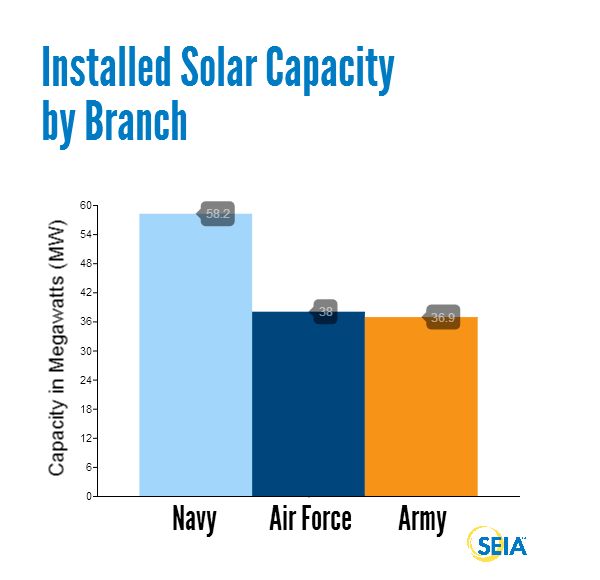
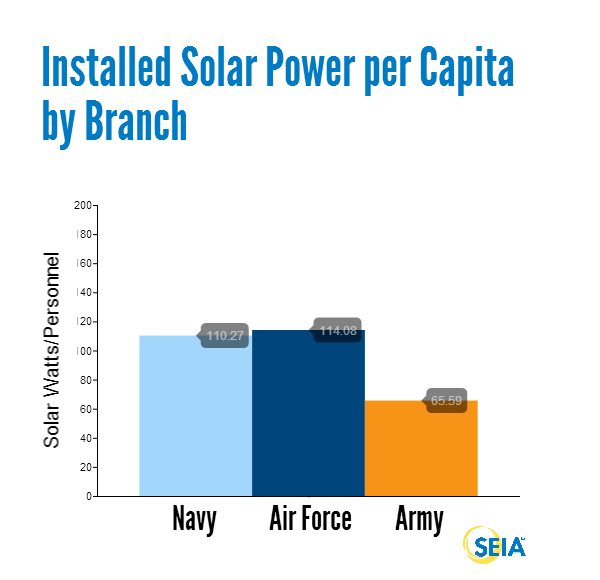
SOLAR PROTECTING MILITARY PERSONNEL ON THE BATTLEFIELD
Solar currently provides the military with operational energy that enhances the “tactical edge” and security of our armed forces abroad.
The military has utilized portable solar arrays to power “fixed-site” locations, many of which are very remote and depend on off-grid power. Solar reduces demand of traditional generators at these discreet locations and in turn, limits the need for costly and dangerous fuel resupply missions that put personnel at risk.
Operational solar also provides these bases with dependable power that is easily portable, compared to obtrusive, heavy, and at times unreliable generators that are often targets for enemy fire.
Companies have developed solar systems that can be attached to backpacks to power GPS and other equipment as well. These solar cells are far lighter and less restrictive than the current batteries most infantry must wear on the battlefield.
With continued advances in technology, solar on the battlefield protects our armed forces and saves lives.
Solar currently provides the military with operational energy that enhances the “tactical edge” and security of our armed forces abroad.
The military has utilized portable solar arrays to power “fixed-site” locations, many of which are very remote and depend on off-grid power. Solar reduces demand of traditional generators at these discreet locations and in turn, limits the need for costly and dangerous fuel resupply missions that put personnel at risk.
Operational solar also provides these bases with dependable power that is easily portable, compared to obtrusive, heavy, and at times unreliable generators that are often targets for enemy fire.
Companies have developed solar systems that can be attached to backpacks to power GPS and other equipment as well. These solar cells are far lighter and less restrictive than the current batteries most infantry must wear on the battlefield.
With continued advances in technology, solar on the battlefield protects our armed forces and saves lives.
For the DOD, the Value Proposition of Solar is Clear
SOLAR PROVIDES ENERGY SECURITY AND INDEPENDENCE
Solar has been and will continue to be instrumental in the DOD’s efforts to procure more secure and independent energy.
On-site solar generation allows the military to be less reliant on aging transmission infrastructure and remote power plants. A solar energy system, coupled with battery backup, a diesel generator or thermal energy storage, can operate in island mode. This allows the solar project to continue to provide power independent from the grid, which provides an extra layer of redundancy and reduces the risk posed by blackouts and potential cyber-attacks.
As the military shifts to solar and away from traditional generation sources, its energy supply will also be less dependent on fossil fuels and less susceptible to global supply and price disruptions. Solar provides the military with locally generated energy that is insulated from natural or man-made instability that could put missions at risk.
SOLAR IS PART OF A LEAN AND EFFICIENT MILITARY
While energy costs continue to rise, DOD budgets have steadily declined. The military has deployed solar installations across the country and abroad to reign in energy expenditures.
The average price of a completed PV system has declined by more than 40% since the beginning of 2011.
In most cases, the military can sign long-term contracts for solar energy that are below local retail rates for electricity. Other federal agencies face contract limits that can drive up the cost of solar and other renewables. Long term solar contracts allow the DOD to hedge against rising and volatile energy costs. Solar will save the military millions of dollars, which in turn can be reinvested to ensure more ready and able armed forces.
SOLAR IS CLEAN
In February 2013, the DOD released a Climate Change Adaption Roadmap (CCAR), which highlights the range of adverse effects climate change has on national security. The report notes that climate change can accelerate instability and conflict around the world and jeopardize missions. Solar provides the DOD with a clean source of energy generation and offsets the military’s greenhouse gas (GHG) emissions. The continued adoption of solar is a response to the potential consequences of climate change that will stress DOD resources in the years ahead. ![]()
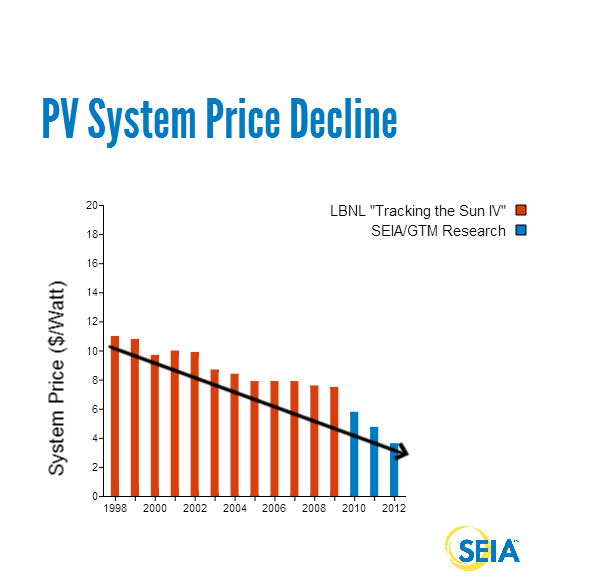
The U.S. military has installed more than 130 MW of solar in 31 states across the country.
Financing Solar Projects for the Military
In order to fully realize the benefits of solar, the military leverages private partnerships to develop and finance projects. The military has used three common third-party structures to develop solar projects: Power Purchase Agreements (PPAs), Enhanced Use Leases (EULs) and Energy Savings Performance Contracts (ESPC).
POWER PURCHASE AGREEMENT (PPA)
A solar PPA is an agreement between a private developer and a host, in this case, the military, in which the developer coordinates the system’s design, construction, and financing while the host purchases the system’s output at a specified rate. Under a PPA, the DOD does not own the project, which allows the military to avoid any up-front cost to develop the project. Rather, the military signs a contract to purchase the energy produced by the solar installation at a price that is below local utility rates, which can save the DOD and taxpayers millions of dollars over the life of the system.
A PPA is an attractive financing structure as it allows the military to capture the benefits of the federal Investment Tax Credit and utilize the value of on-site solar generation at no up-front cost. As a non-taxable entity, the military must depend on a third-party to monetize tax credits. The agreement also minimizes risk to the military because the developer is responsible for system performance and only receives payments for the power delivered.
ENHANCED USE LEASE
An enhanced use lease (EUL) is an arrangement in which a private developer leases land from the military to develop a solar project. In most cases, the private developer provides the DOD with rental payments, either monetary or other in-kind considerations, which can be applied directly back into the improvement of the base. While the military does not purchase the energy from the solar project directly, the systems do supply power to the nearby grid.
EULs are especially attractive when a military facility has available land and solar resources, but does not have the on-site demand for a large, centralized project. An EUL allows the military to meet its renewable energy targets while at the same time foster job creation and promote environmental stewardship.
ENERGY SAVINGS PERFORMANCE CONTRACT (ESPC)
An ESPC is a partnership between a federal agency and a private sector company, also referred to as an energy service company (ESCO), which allows the military to procure energy projects with no upfront capital outlay. ESPCs are signed for the purpose of improving infrastructure to achieve energy savings and allow for renewable energy generation. ESCO payments are based on the anticipated or actual energy savings generated by the renewable energy project.
Solar Growing in Each Branch
NAVY
In 2009, Secretary of the Navy Ray Mabus outlined that energy security and energy independence should be the two pillars that drive the Navy’s energy program. In response to these objectives, Secretary Mabus announced that by 2020, the Navy would obtain 50 percent of its energy from renewable sources, which far exceeds the DOD’s 25 percent by 2025 mandate.
To reach Secretary Mabus’ ambitious target, the Department of the Navy (DON) established a 1 GW Task Force to oversee the procurement of 1 GW of renewable energy capacity by 2020. Solar is expected to be instrumental in the Navy’s efforts to meet these goals in the upcoming years. PV comprises 57 percent of all DON planned renewable energy capacity additions from 2012 to 2017 and provides the Navy with a more secure and independent generation mix.
Solar also has a significant share of the Navy’s current renewable energy portfolio. As of early 2013, there are more than 58 MW of solar PV operating at DON installations in 12 states and the District of Columbia, more than either the Army or Air Force. DON has also awarded more than 20 MW of PV projects, including installations at Marine Corps Base (MCB) Camp Lejeune, North Carolina and MCB Camp Pendleton, California among others that will come online in the near future.
As of early 2013, there are more than 58 MW of solar PV operating at DON installations in 12 states and the District of Columbia, more than either the Army or Air Force.
To help meet Secretary Mabus’s targets, the 1 GW Task Force has also outlined specific initiatives that will aggregate projects and streamline environmental and transmission reviews to ensure efficient and timely completion of future projects.
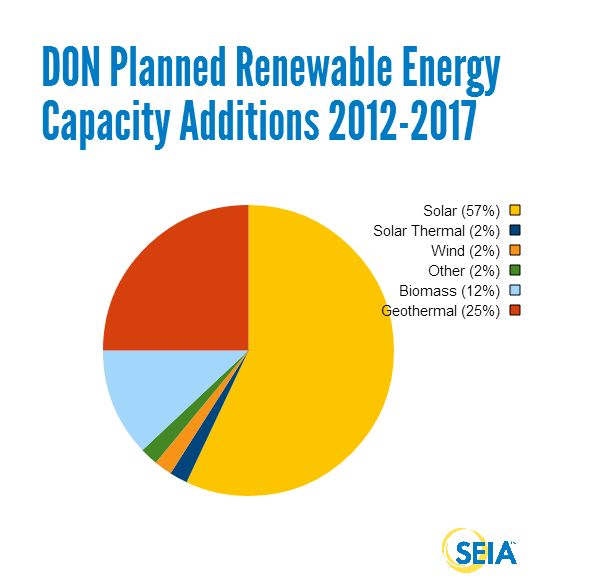
CASE STUDY:
CHINA LAKE NAVAL AIR WEAPONS STATION
While the project was significant in size, it also marked the first time a federal agency generation project was financed through a 20-year power purchase agreement under USC 2922A. Under the agreement, the Navy signed a contract to purchase the power generated from the project, while SunPower financed and built the system. The PPA allowed the Navy to avoid an upfront capital outlay and purchase secure and clean energy at a predictable rate well below retail prices.
Before the China Lake contract was signed, most military energy procurement agreements had a 10-year tenor. Shorter contract terms drive up power prices. With the shorter tenor, the developer’s project costs had to be recovered within the 10 years, which pushed most savings beyond the 10-year budget cycle. A longer contract term allows the military to realize savings generated from the project immediately. It is estimated that the 20-year PPA length allowed the Navy to procure output from China Lake at rates 30 percent below the price it would have paid under a 10-year agreement.
CHINA LAKE NAVAL AIR WEAPONS STATION
In October 2012, the Navy announced the completion a 14-MW PV project at the Naval Air Weapons Station China Lake in California, its largest operating solar project to date. The solar farm, developed and constructed by SunPower Corp., will generate enough clean energy to supply 30 percent of the facility’s annual electricity needs, save the Navy and taxpayers an estimated $13 million over the 20-year life of the project and increase the energy security of the weapons station.
While the project was significant in size, it also marked the first time a federal agency generation project was financed through a 20-year power purchase agreement under USC 2922A. Under the agreement, the Navy signed a contract to purchase the power generated from the project, while SunPower financed and built the system. The PPA allowed the Navy to avoid an upfront capital outlay and purchase secure and clean energy at a predictable rate well below retail prices.
Before the China Lake contract was signed, most military energy procurement agreements had a 10-year tenor. Shorter contract terms drive up power prices. With the shorter tenor, the developer’s project costs had to be recovered within the 10 years, which pushed most savings beyond the 10-year budget cycle. A longer contract term allows the military to realize savings generated from the project immediately. It is estimated that the 20-year PPA length allowed the Navy to procure output from China Lake at rates 30 percent below the price it would have paid under a 10-year agreement.
AIR FORCE
As the largest consumer of energy in the DOD and in light of constrained budgets, the Air Force (USAF) has taken proactive and accelerated measures to diversify its generation mix and reduce energy costs. In the spring of 2012, the Air Force announced it would procure 1 GW of renewable power by 2016, which will allow the USAF to exceed all DOD mandates, including 10 USC 2911.
Solar will be critical to the Air Force’s efforts to meet its 2016 target. PV is planned to account for over 70 percent of all new Air Force renewable energy capacity added from 2012 to 2017, which will represent a significant expansion of the USAF’s current solar installations. The branch’s commitment to solar reflects the USAF’s objectives to lower expenditures and provide personnel with reliable and secure energy.
As of early 2013, there are 38 MW of solar PV capacity operating at Air Force bases in 24 states, enough to power more than 5,600 American homes. While the Air Force is behind the Navy in terms of installed solar capacity, the USAF has announced plans to add more than 26 MW of PV in 2013 alone. A 14.5-MW project at Davis-Monthan, Arizona, which will become the Air Force’s largest operating solar project, and as a 6-MW array at Otis Air National Guard Base, Massachusetts are both expected to come online by the end of 2013. The Air Force has also outlined solar projects at military residences at the Los Angeles Air Force Base and the Schriever Air Force Base, among others, through Project SolarStrongTM. All of these projects, both at the utility and distribution levels, are anticipated to provide the Air Force with millions of dollars in energy savings over the lives of the systems.
CASE STUDY:
HICKAM COMMUNITIES, HICKAM AIR FORCE BASE
Since the summer of 2011, SolarCity Corp. has been working to construct one of the largest solar communities in the nation at Hickam Air Force Base in Honolulu, Hawaii. To date, SolarCity has installed and interconnected 3.4 MW for the 2,000-home community, with additional systems under technical review that could eventually bring approximately 5.5 MW in solar PV system capacity to Hickam Communities.
Hickam Communities entered into a 20-year PPA with SolarCity to purchase the energy generation of the hundreds of projects installed throughout the community. SolarCity has and will continue to engineer, install, monitor and maintain the systems throughout the 20-year contract term. The project will provide Hickam Communities with significant energy savings over the life of the system and allow the USAF to work towards meetings DOD renewable energy mandates at no up-front cost. The continued adoption of PV across communities like Hickam also reduces Hawaii’s dependence on costly, dirty foreign oil for electricity generation.
The Hickam Communities project is part of SolarStrong, a five-year $1 billion initiative to provide solar electricity for up to 120,000 U.S. military homes across all three branches of the DOD. Once completed, it will be one of the largest residential solar initiatives in the country. Other SolarStrong projects are underway at Los Angeles Air Force Base, California and Peterson and Schriever Air Force Bases in Colorado. A 929-home project at Davis-Monthan Air Force Base, Arizona, announced in 2009, provided the initial blueprint for SolarStrong.
Recently, SolarCity also started construction of a large new project to provide solar electricity to 6,500 military family residences at Ohana Military Communities (OMC), which serves Navy Region Hawaii and Marine Corps Base Hawaii. This latest SolarStrong project is scoped for a planned 24 megawatts (MW) of generation capacity.
HICKAM COMMUNITIES, HICKAM AIR FORCE BASE
Since the summer of 2011, SolarCity Corp. has been working to construct one of the largest solar communities in the nation at Hickam Air Force Base in Honolulu, Hawaii. To date, SolarCity has installed and interconnected 3.4 MW for the 2,000-home community, with additional systems under technical review that could eventually bring approximately 5.5 MW in solar PV system capacity to Hickam Communities.
Hickam Communities entered into a 20-year PPA with SolarCity to purchase the energy generation of the hundreds of projects installed throughout the community. SolarCity has and will continue to engineer, install, monitor and maintain the systems throughout the 20-year contract term. The project will provide Hickam Communities with significant energy savings over the life of the system and allow the USAF to work towards meetings DOD renewable energy mandates at no up-front cost. The continued adoption of PV across communities like Hickam also reduces Hawaii’s dependence on costly, dirty foreign oil for electricity generation.
The Hickam Communities project is part of SolarStrong, a five-year $1 billion initiative to provide solar electricity for up to 120,000 U.S. military homes across all three branches of the DOD. Once completed, it will be one of the largest residential solar initiatives in the country. Other SolarStrong projects are underway at Los Angeles Air Force Base, California and Peterson and Schriever Air Force Bases in Colorado. A 929-home project at Davis-Monthan Air Force Base, Arizona, announced in 2009, provided the initial blueprint for SolarStrong.
Recently, SolarCity also started construction of a large new project to provide solar electricity to 6,500 military family residences at Ohana Military Communities (OMC), which serves Navy Region Hawaii and Marine Corps Base Hawaii. This latest SolarStrong project is scoped for a planned 24 megawatts (MW) of generation capacity.
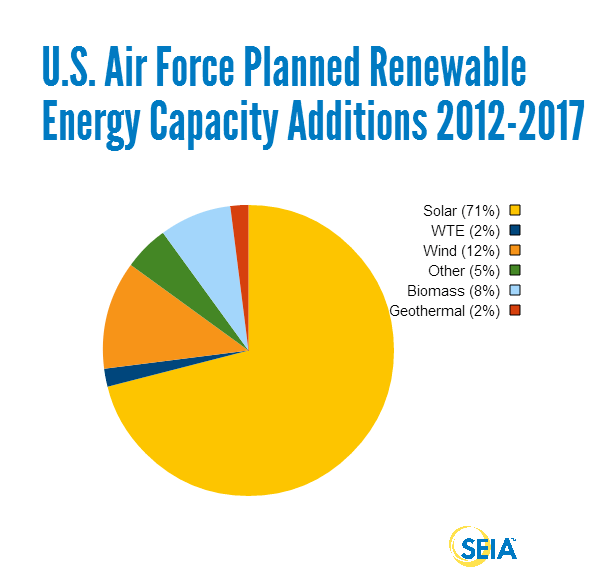 |
| Añadir leyenda |
ARMY
The Army has formed specific and aggressive renewable and net-zero energy goals, and has looked to solar specifically to help meet these targets. Like the Navy and Air Force, the Army has also implemented plans to procure 1 GW of renewable energy capacity in an effort to satisfy the DOD’s 25 percent renewables by 2025 mandate and increase the energy security of bases. The Army is focused on the continued adoption of solar to cost effectively enhance the branch’s mission effectiveness.
In September 2011, the Army established the Energy Initiatives Task Force (EITF) to serve as the central renewable procurement office for projects 10 MW or larger. The EITF’s development process is driven by DOD mandates, energy security and economic benefits and it will utilize private partnerships and investment. Solar allows the Army to move forward with its renewable energy plans and adhere to all EITF objectives.
As of early 2013, there are more than 36 MW of solar PV installed at different Army bases in at least 16 states. While the Army has enough solar installed to power well over 5,000 American homes, its solar portfolio is poised to expand significantly in the upcoming months and years. Solar comprises a third of the Army’s planned renewable generating capacity additions from 2012 to 2017. The EITF has moved forward with two 20-MW solar projects at Fort Irwin, California and Fort Bliss, Texas, as well as a “micro-grid ready” 15-MW system at Fort Detrick, Maryland, which will be able to provide critical power to the base in the event of a power outage. Through Project SolarStrong, the Army has also announced plans to install solar on the roofs of 4,700 military homes at Fort Bliss, which will total more than 13 MW.
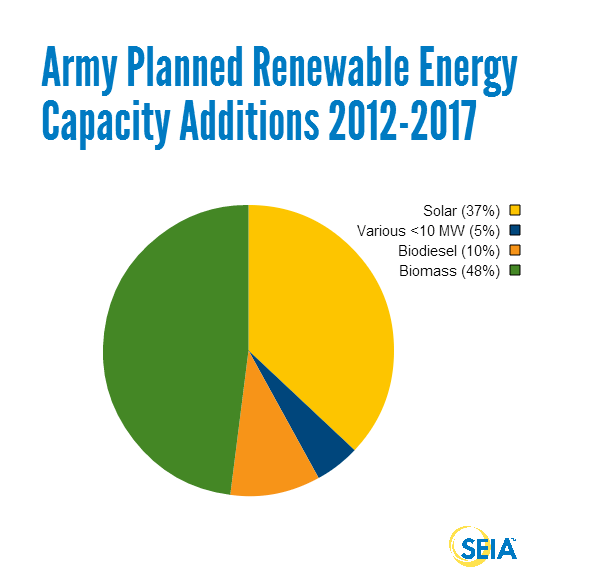
CASE STUDY:
WHITE SANDS MISSILE RANGE
![]() In January 2013, the Army dedicated the White Sands Missile Range Solar Project in New Mexico. At 4.1 MW, the ground-mounted, low concentration PV project is the largest operating solar project in the Army and will generate enough electricity to meet 10 percent of the missile range’s electricity needs. The White Sands solar project, which utilizes Solaria Corp’s proprietary tracking technology, will ultimately save the Army an estimated $900,000 annually and displace 7,400 tons of carbon emissions each year. The added solar generation also diversifies the missile range’s energy supply and generation mix.
In January 2013, the Army dedicated the White Sands Missile Range Solar Project in New Mexico. At 4.1 MW, the ground-mounted, low concentration PV project is the largest operating solar project in the Army and will generate enough electricity to meet 10 percent of the missile range’s electricity needs. The White Sands solar project, which utilizes Solaria Corp’s proprietary tracking technology, will ultimately save the Army an estimated $900,000 annually and displace 7,400 tons of carbon emissions each year. The added solar generation also diversifies the missile range’s energy supply and generation mix.
The White Sands solar farm was the primary piece of an Energy Savings Performance Contract (ESPC) that was awarded and managed by the U.S. Army Engineering and Support Center. The ESPC was ultimately implemented by Siemens Government Technologies, who incurred the upfront cost of the installation and will operate and maintain the project through the 25-year contract. Siemens will sell all the energy generated from the solar farm to the White Sands Missile Range.
The ESPC with Siemens highlights the range of benefits of a private-public partnership. The contract allowed the Army to lower its operating costs, strengthen the missile range’s energy security and create local jobs at no up-front cost.
WHITE SANDS MISSILE RANGE
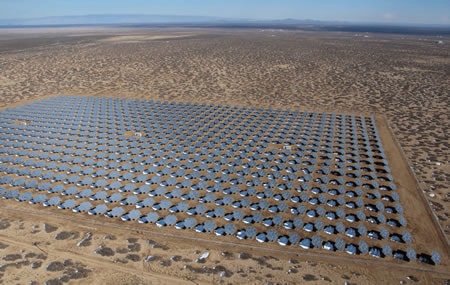 In January 2013, the Army dedicated the White Sands Missile Range Solar Project in New Mexico. At 4.1 MW, the ground-mounted, low concentration PV project is the largest operating solar project in the Army and will generate enough electricity to meet 10 percent of the missile range’s electricity needs. The White Sands solar project, which utilizes Solaria Corp’s proprietary tracking technology, will ultimately save the Army an estimated $900,000 annually and displace 7,400 tons of carbon emissions each year. The added solar generation also diversifies the missile range’s energy supply and generation mix.
In January 2013, the Army dedicated the White Sands Missile Range Solar Project in New Mexico. At 4.1 MW, the ground-mounted, low concentration PV project is the largest operating solar project in the Army and will generate enough electricity to meet 10 percent of the missile range’s electricity needs. The White Sands solar project, which utilizes Solaria Corp’s proprietary tracking technology, will ultimately save the Army an estimated $900,000 annually and displace 7,400 tons of carbon emissions each year. The added solar generation also diversifies the missile range’s energy supply and generation mix.The White Sands solar farm was the primary piece of an Energy Savings Performance Contract (ESPC) that was awarded and managed by the U.S. Army Engineering and Support Center. The ESPC was ultimately implemented by Siemens Government Technologies, who incurred the upfront cost of the installation and will operate and maintain the project through the 25-year contract. Siemens will sell all the energy generated from the solar farm to the White Sands Missile Range.
The ESPC with Siemens highlights the range of benefits of a private-public partnership. The contract allowed the Army to lower its operating costs, strengthen the missile range’s energy security and create local jobs at no up-front cost.
CASE STUDY:
MARINE CORPS BASE CAMP LEJEUNE
The DoD utilizes thermal energy from the sun at military buildings and homes throughout the country using solar heating and cooling (SHC) technologies. These SHC technologies collect the thermal energy from the sun and use its heat to provide hot water, space heating, cooling, and pool heating for a variety of residential and other applications. In 2012, FLS Energy completed the nation’s largest solar water heating project in the continental United States at Marine Corp Base Camp Lejeune in Jacksonville, North Carolina. There are 2,200 solar water heating systems installed at Camp Lejeune, which generate enough thermal energy to meet 75 percent of the daily hot water needs for each military home equipped.20
Atlantic Marine Corps Communities, which develops and manages base housing at Camp Lejeune, signed a contract to purchase the energy produced from the solar water heating installations. This agreement allows the base to purchase the output from the systems to heat water at prices 20 percent below the cost of heating water with electricity from the grid. With no upfront capital expenditure needed, the project will save military funds as budgets continue to tighten. The money saved will allow for the addition of new homes for military families and the renovation of existing homes at the base, which will improve the lives of our armed forces and diversify the base’s energy resources.
MARINE CORPS BASE CAMP LEJEUNE
The DoD utilizes thermal energy from the sun at military buildings and homes throughout the country using solar heating and cooling (SHC) technologies. These SHC technologies collect the thermal energy from the sun and use its heat to provide hot water, space heating, cooling, and pool heating for a variety of residential and other applications. In 2012, FLS Energy completed the nation’s largest solar water heating project in the continental United States at Marine Corp Base Camp Lejeune in Jacksonville, North Carolina. There are 2,200 solar water heating systems installed at Camp Lejeune, which generate enough thermal energy to meet 75 percent of the daily hot water needs for each military home equipped.20
Atlantic Marine Corps Communities, which develops and manages base housing at Camp Lejeune, signed a contract to purchase the energy produced from the solar water heating installations. This agreement allows the base to purchase the output from the systems to heat water at prices 20 percent below the cost of heating water with electricity from the grid. With no upfront capital expenditure needed, the project will save military funds as budgets continue to tighten. The money saved will allow for the addition of new homes for military families and the renovation of existing homes at the base, which will improve the lives of our armed forces and diversify the base’s energy resources.
With over 130 MW of operating solar projects at Navy, Air Force and Army bases in at least 31 states plus DC, the military is on a clear path to become a leading player in the solar market. The continued adoption of solar across the country is the military’s answer to rising energy costs and security issues associated with a conventional fuel supply and aging transmission network. Solar provides each branch with dependable, locally generated and cost-effective energy that saves the military money and alleviates energy security concerns.
Solar energy is playing an increasingly important role in making the U.S. military’s energy supply more secure, more affordable and less reliant on foreign sources.
While the DOD’s operating solar portfolio marks a significant shift in the DOD’s procurement thought process, the military’s current solar installations are only the foundation for each branch’s ultimate energy goals. The military has outlined plans to install hundreds of additional MW’s of solar that will transform the DOD’s energy supply. Solar’s rapidly growing role in the military will ensure a more able, efficient and secure armed forces in the years ahead.


